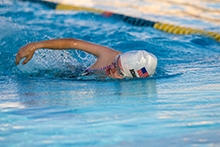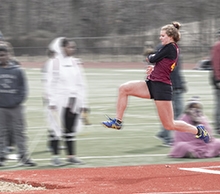Nelya Schasfoort is only 15-years-old and she’s already broken world records and has a mindset of making Tokyo 2020.
15-year-old Nelya Schasfoort has some advice for kids who grow up with a disability, from personal experience. Sports have helped her throughout her life and she wants you to know sports can help you, too.

“You have nothing to lose. You can go in as a beginner and come out as an amazing person. You’ll meet people and become lifelong friends. You’ll always have something to gain. It is amazing being in the Paralympic world because everyone gets you and everyone knows who you are. When I go to regular high school, I’m nervous because everyone stares but when I go to Paralympic events no one stares and if they do it’s because they want to meet you because maybe you’re just like them. You have your whole life in front of you, so try it out,” Schasfoort says.
Schasfoort has arthrogryposis, which is a condition where the child is born with joint contractures. With arthrogryposis, some of your joints don’t move much and may be stuck in one position. This condition causes the muscles around the joints to be thin, weak, stiff or missing all together. In Schasfoort’s case, she has it in her arms. Her muscles aren’t fully developed, and she is missing all muscles in her shoulders.
“I have weird connections with my bones,” Schasfoort says. “My elbows are either straight and can’t bend, or they are stuck in a bent motion. My shoulders are also just bones, so they are very skinny and so are my arms, but my lower body is very good and very healthy.”

Schasfoort started swimming at a very early age as a form of physical therapy and shortly fell in love with the sport.
“Swimming helped a lot and it wasn’t long until I became in love with it and my parents could never take me out of the water,” Schasfoort says.
Once her parents saw her love of swimming, they put her in a club and later heard about the Paralympics. After competing in a few meets, Schasfoort made Team USA and started traveling for swim meets.
Schasfoort is a natural athlete. She started in track only one year ago and is already breaking world records. In the summer of 2017, Schasfoort traveled to Switzerland for a track meet and finished 1:11:17 in the 400-meter race which beat 20-year world record.
“I ended up crushing the world record and making one of my own. I was so excited, it was so cool and amazing just to know that I did that,” she says.
After a great year of record breaking, Schasfoort will be traveling to Ireland this summer to compete at the Junior International Wheelchair and Amputee Sports (IWAS) Games and Women’s World IWAS representing Team USA.
“Being on Team USA means a lot, I love it and I can really be myself because I’m surrounded by other people with disabilities,” Schasfoort says. “I can be my best and I can show that I can improve and work with new coaches and it’s amazing, I feel very happy about it.”
As the IWAS Games approach, Schasfoort continues to train with her high school. Over the summer, she is setting off to Peru for three weeks for altitude sprint training.
Schasfoort has had to work very hard to get to where she’s at. With her condition, Schasfoort had a hard time with swimming and running at first. With swimming, her arms were really challenging to work with. She has a hard time getting her arms over her head, so she had to adapt to a new way of swimming. Her left arm always brings down her right, so she was able to find new ways to use her arms.
“For the butterfly, I don’t do two arms, I just do one arm and it’s been a big help,” she says. “I just kind of learned to push the left away and use the right, and that was a big change because I had always been trying to do two arms. We figured out that one arm would work, and that’s how it’s been going with most of my strokes, I finally figured out that I just have to use my right arm and we kind of just let the left arm do its own thing.”
As for running, having to adapt was less of a challenge since she mostly uses her healthy lower body. Her arms would swing in front of her body rather than on the sides, so she had to train how to physically make her arms go to the side of her body. After a lot of training, she was able to become strong enough to keep her arms at the side of her body while running.
Sports have helped Schasfoort feel more confident not only athletically but in her everyday life.
“When I stopped swimming and running for a little bit, I felt like I wasn’t proud of something,” she says. “I could tell in my everyday life that there was this piece missing, and I knew sports made me happy, confident and makes me who I am.”
Schasfoort’s goal is to make it to Tokyo 2020.
“Everything I do is for my future, whether it’s going to practice, working hard, eating healthy, taking my vitamins – everything is me working towards me future,” Schasfoort says.